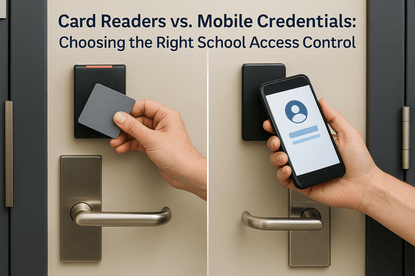
The front doors of your school are more than just an entrance—they’re the first line of defense in your safety strategy. As schools upgrade their access control systems, one question keeps coming up:
Should we use traditional card readers, or switch to mobile credentials?
Both options offer secure entry, automated tracking, and integration with broader school safety platforms. But when it comes to convenience, cost, and long-term flexibility, one may be a better fit than the other.
This guide breaks down the pros and cons of each, helping you make the best decision for your school community.
k
k
🧾 What Are We Comparing?
🔑 Card Readers (Proximity Cards or Key Fobs):
-
Staff and students carry a physical badge or fob.
-
Readers installed at doors scan and unlock access points.
-
Common in many legacy systems.
📱 Mobile Credentials (Smartphone-Based Access):
-
Access is granted via an app or digital ID stored on a phone.
-
Phones communicate with readers using Bluetooth, NFC, or QR codes.
-
Increasingly popular in higher education and enterprise settings, and now emerging in K–12.
k
k
📊 Side-by-Side Comparison
| Feature | Card Readers | Mobile Credentials |
|---|---|---|
| Security | Medium | High (encrypted, device-bound) |
| Convenience | Requires carrying badge | Already on phone |
| Lost/Stolen Risk | High | Lower (phones usually locked) |
| Cost Over Time | Repeated card reprints | Fewer recurring costs |
| Admin Burden | Manual distribution & revocation | Can be issued/revoked remotely |
| Integration Potential | Standard integrations | Advanced integrations (apps, alerts) |
| Adoption in K–12 | Very common | Emerging, growing fast |
k
k
k
🔐 Security Considerations
-
Card Cloning Is a Real Threat
Prox cards and fobs can be easily duplicated with cheap equipment. If a student loses their badge, anyone could gain access undetected. -
Phones Offer Built-In Encryption
Mobile credentials are often stored in secure digital wallets and require biometric authentication to unlock. That makes unauthorized use significantly harder. -
Revoking Access Is Easier With Mobile
If a student transfers or a staff member leaves, revoking mobile access can be done instantly—without waiting for badge returns.
k
k
💸 Cost Considerations
-
Card Systems Have Hidden Ongoing Costs
Lost cards, replacements, badge printers, and lanyards add up—especially in large districts. -
Mobile Credentials Reduce Physical Overhead
No need for physical inventory or shipping. And most students already carry a smartphone.
🎯 Districts with high badge turnover or frequent staff changes often find mobile systems more cost-effective over time.
k
k
👨🏫 Usability for Students and Staff
-
Students Frequently Misplace Badges—Not Phones
With mobile credentials, you reduce entry delays and the need for manual check-ins. -
Badge Discipline Challenges Disappear
Forgetting or losing a badge becomes a non-issue when access is tied to a phone. -
For Younger Students:
If implementing mobile credentials for K–5 is a concern, some systems allow a hybrid approach—cards for students, mobile access for staff and visitors.
l
l
🧠 Integration & Innovation Potential
Modern mobile access platforms often:
-
Integrate with emergency alert systems
-
Offer real-time visitor logs
-
Support touchless entry
-
Tie into district-wide security dashboards
📱 Imagine unlocking the door, sending a check-in signal, and logging your arrival—all in one tap.
k
k
🛠️ Transition Tips: Moving to Mobile Access
-
Pilot with Staff or a Single Building First
Test adoption and iron out any connectivity or policy issues. -
Use a Dual System During the Transition
Let users choose between card and mobile credentials during rollout. -
Train and Communicate Early
Prepare staff, parents, and students with how-tos and support materials. -
Pick an Access Control Partner That Supports Both
Choose a flexible system that allows you to mix mobile and card access based on grade level, role, or building type.
k
k
✅ The Verdict: Which One Is Right for Your School?
| Situation | Best Fit |
|---|---|
| Large campus with consistent staff | Mobile credentials |
| High badge turnover (substitutes, volunteers) | Mobile credentials |
| Elementary schools without phone access | Card readers (with staff on mobile) |
| Older legacy system in place | Card readers (with phased mobile upgrade) |
Ultimately, mobile credentials offer greater long-term flexibility, better security, and a more modern user experience—especially for middle and high schools.
But a hybrid approach can allow districts to evolve without creating friction.
k
k
🔐 Want to See Mobile Access in Action?
SSP offers mobile-ready access control systems designed for K–12 environments.
Whether you're upgrading or starting from scratch, we’ll help you secure every entrance—smartly and affordably.


